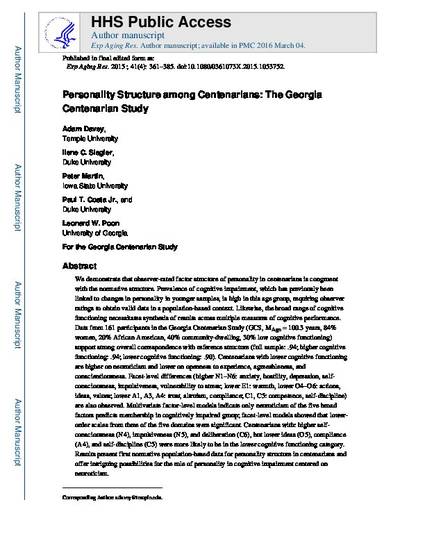
Background/Study Context: We demonstrate that observer-rated factor structure of personality in centenarians is congruent with the normative structure. Prevalence of cognitive impairment, which has previously been linked to changes in personality in younger samples, is high in this age group, requiring observer ratings to obtain valid data in a population-based context. Likewise, the broad range of cognitive functioning necessitates synthesis of results across multiple measures of cognitive performance.
Methods and Results: Data from 161 participants in the Georgia Centenarian Study (GCS; MAge = 100.3 years, 84% women, 20% African American, 40% community-dwelling, 30% low cognitive functioning) support strong overall correspondence with reference structure (full sample: .94; higher cognitive functioning: .94; lower cognitive functioning: .90). Centenarians with lower cognitive functioning are higher on neuroticism and lower on openness to experience, agreeableness, and conscientiousness. Facet-level differences (higher N1–N6: anxiety, hostility, depression, self-consciousness, impulsiveness, vulnerability to stress; lower E1: warmth; lower O4–O6: actions, ideas, values; lower A1, A3, A4: trust, altruism, compliance; C1, C5: competence, self-discipline) are also observed. Multivariate factor-level models indicate only neuroticism of the five broad factors predicts membership in cognitively impaired group; facet-level models showed that lower-order scales from three of the five domains were significant. Centenarians with higher self-consciousness (N4), impulsiveness (N5), and deliberation (C6) but lower ideas (O5), compliance (A4), and self-discipline (C5) were more likely to be in the lower cognitive functioning category.
Conclusion: Results present first normative population-based data for personality structure in centenarians and offer intriguing possibilities for the role of personality in cognitive impairment centered on neuroticism.
Available at: http://works.bepress.com/peter-martin/8/

This is an accepted manuscript published as Davey, Adam, Ilene C. Siegler, Peter Martin, Paul T. Costa Jr, Leonard W. Poon, and Georgia Centenarian Study. "Personality Structure Among Centenarians: The Georgia Centenarian Study." Experimental aging research 41, no. 4 (2015): 361-385. doi: 10.1080/0361073X.2015.1053752. Posted with permission.